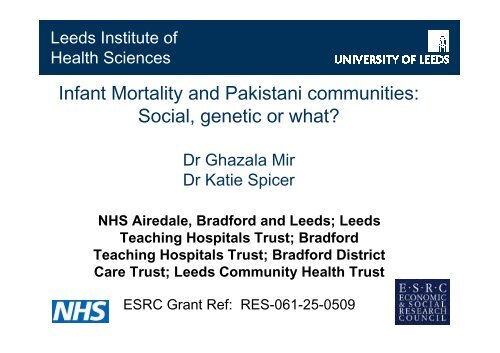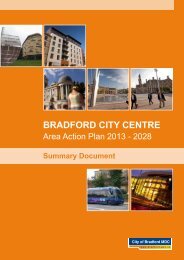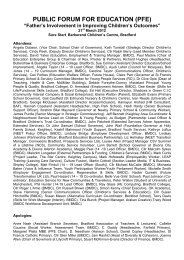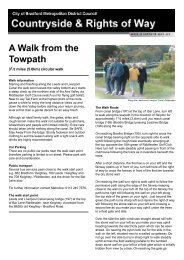Genetics Conference Presentation Dr Ghazala Mir and Dr Katie Spicer
Genetics Conference Presentation Dr Ghazala Mir and Dr Katie Spicer
Genetics Conference Presentation Dr Ghazala Mir and Dr Katie Spicer
- No tags were found...
You also want an ePaper? Increase the reach of your titles
YUMPU automatically turns print PDFs into web optimized ePapers that Google loves.
Background• Social exclusion <strong>and</strong> inequalities in infant mortality• UK rates of infant mortality for mothers born inPakistan, the Caribbean <strong>and</strong> teenage mothers are100%, 63% <strong>and</strong> 60% higher than the national raterespectively• Risk reduction strategies suggested includeoptimising maternal <strong>and</strong> mental health <strong>and</strong>addressing environmental stressors (DH 2007),improved services <strong>and</strong> increased social support forwomen at risk
Plan of investigationFour phases:• Explore the current evidence, policy guidance <strong>and</strong> localcontext (Leeds <strong>and</strong> Bradford).• Recruit <strong>and</strong> interview women from a range ofbackgrounds in two matched groups (30 at each site)who have(i) experienced an infant death(ii) a child over one year old• Analyse data using quantitative <strong>and</strong> qualitative methods.• Project development group aimed at finding solutions tothe problems identified using participatory researchmethods
Workshop Outline• Review of infant mortality policy withreference to ethnicity• Review of evidence for impact of pre<strong>and</strong> post natal social support on birthoutcomes• Data from key informant interviews• Questions for group discussion
National Infant Mortality Policy <strong>and</strong>Ethnicity• Infant Mortality as a component of NHS plan(2000)• 2002 National Health Inequalities PSA target <strong>and</strong>infant mortality action plan a key part of publichealth strategy• Main focus of target is socio-economic inequality• However, recognition within 2007 Dept of Healthreview of target that certain groups such aswomen born in Pakistan have significantly higherrisk
Scarf Diagram
National <strong>and</strong> Local Policy <strong>and</strong>Ethnicity• Recognition within DoH review of significance ofinterplay between poverty <strong>and</strong> ethnicity• Yet not reflected in key targets as outlined inscarf diagram• <strong>Genetics</strong> service in Blackburn given as goodpractice example, among other case studies• Risk of obscuring significance of complexinteraction of socioeconomic status <strong>and</strong> otherfactors around access to care in causal pathwaysfor IM
Existing evidenceEvidence for complexity within explanations ofvariations in infant mortality:•4% of consanguineous couples have a child with acongenital abnormality compared to 2% otherwise(Modell <strong>and</strong> Darr 2002)•Rates of terminations for an anomaly vary amongdifferent ethnic <strong>and</strong> socioeconomic groups•Socio-economic status as a key risk factor for infantmortality, closely intertwined with ethnicity•Support available to women also linked to higherrates of infant death
Social support <strong>and</strong> infant mortality 1• Evidence for significance of quality <strong>and</strong> type ofsupport accessible to women <strong>and</strong> families pre- <strong>and</strong>post-natally• Health outcomes for mothers <strong>and</strong> infantsinfluenced by– presence of a birth companion (Sosa et al 1990)– quality <strong>and</strong> type of social support from partner, family <strong>and</strong> friends(Austerberry et al 2007)– connectedness in social network- facilitating access to material <strong>and</strong>informational resources, but network may reflect poverty <strong>and</strong>disadvantage/lack of resources (Gayen <strong>and</strong> Raeside 2007)– Perceived quality of support from all sources more impactful onhealth outcomes, not frequency of support (Oakley et al, 1994)
Social support <strong>and</strong> infant mortality 2• NPEU survey of women’s experience of maternity care(2010) found:– later booking for women from minority ethnic groups (which mayresult in inequalities in prenatal testing (Smith et al, 2011))– less awareness of choices around maternity care– less trust <strong>and</strong> confidence in staff• Health Care Commission review of maternity services(2008): women from minority ethnic groups more likely to beleft alone during labour <strong>and</strong> report feeling worried by this,an example of discrimination within healthcare contexts• Recognition from health care professionals of trainingneeds such as in effective communication, <strong>and</strong> skill gapsbeyond dealing with particular issues such as sickle cellanaemia (Chevannes 2002)
<strong>Genetics</strong> <strong>and</strong> infant mortality• Complex area with lots of uncertainty (Kurinczuk 2010)– Congenital anomalies contribute about one third of the extra infantdeaths in routine <strong>and</strong> manual groups– 4 x higher risk of infant death from CA in Pakistani babies– underlying cause most often not known– not always possible to offer genetic screening• Inequalities between socioeconomic <strong>and</strong> ethnic groups for 9fatal anomalies disappear when terminations taken into account(Smith et al 2011)– Lower rates of termination amongst Pakistani women not takeninto account in infant mortality figures– But rare conditions may not be covered by the anomaliesinvestigated
Key Informant Interviews: Ethnicity<strong>and</strong> risk• Deprivation (lbw), prematurity, communicationbarriers, genetic risk/terminations, quality ofhealthcare, health literacy, confidence <strong>and</strong>capacity to seek support• Good practice adaptations to meet needs but notroutine or embedded within mainstream services:– Haamla, Choto Moni, Mothers in Exile, MaternityOutreach Volunteers– Bradford Doulas, <strong>Genetics</strong> training/campaign• Ethnicity not a trigger to explore related risk factorsdespite higher rates of infant mortality
Ethnicity <strong>and</strong> network relationshipsStaff shortages/pressures/dynamics within teamsStaff in mainstream services not representative of minorityethnic communities - impact on relationships•Ability to respond, lack of empathy - ‘task-based’ rather thancaring relationships•Interactions influenced by perceptions of group identity/stereotypes <strong>and</strong> what people ‘think they know’/ ‘instincts’:“it’s very like when you read accounts of Britain in Victoriantimes, that, you know, the woman was the last person to eatin the family. She makes sure the children eat, her husb<strong>and</strong>eats, that they’re all sorted, <strong>and</strong> then, if she’s got time, shethinks of herself”
<strong>Genetics</strong> <strong>and</strong> infant death• Consanguinity perceived as a ‘sensitive area’,‘inherently dangerous’ <strong>and</strong> major explanatory factor• Reduced credibility of those who suggest a morecomplex perspective - ‘in denial’; ‘minimiser’; ‘not anexpert’. Different positions seen as a ‘cultural divide’• Genetic awareness a part-solution: clearer pathwaysneeded for better access to genetic counselling forindividuals/affected families - ‘primary prevention’.• Termination after diagnosis of CA a moral decision withconsequences for well being of woman <strong>and</strong> child – needfor broader service responses to these decisions
Research <strong>and</strong> ethnicity• Research role in Family Nurse Partnershipprogramme - exclusion of young BME women withlanguage needs <strong>and</strong> risk factors not explored ifwith family (migration, isolation, deprivation,access)• Parallel intervention suggested for BME women –ie targeted programme of comprehensive support• Lack of local research a reason for lack of localaction (cf teenage pregnancy pathway).• Feedback mechanisms for service developmentunderrepresent BME women
Religion <strong>and</strong> ‘risk factors’• Supportive: eg Muslim chaplains/religious authorities supportingbreastfeeding advice; mosques disseminating health promotionmaterials.• Supporting women/conflicting with professionals: Somereligious authorities perceived to be ‘in denial’ about geneticexplanations for infant mortality. Muslim staff seen as ‘dissuading’post mortems considered ‘very important indeed’ by doctors repotential for informing about future pregnancies. Religiousteachings on terminations• Stereotypes/prejudicial views of Islam may be promotedamongst professional actors – influenced by ethnic <strong>and</strong> socialclass as well as religious differences. Professional relationshipwith individual women may be influenced by their perception ofwomen’s social identity before interaction has even taken place
Conclusion• Importance of a broader approach, responsive tospecifics of local context• Design <strong>and</strong> delivery of a genetics service must betailored to local situations, needs <strong>and</strong> perspectives• Vital to address challenges in delivering healthcare <strong>and</strong> support to women <strong>and</strong> families fromminority ethnic groups• These challenges are likely to play out in thedelivery of a genetics service <strong>and</strong> could threaten itssuccess
Discussion questionWhat should a strategy for reducing infantmortality in the Pakistani community looklike?How might this address:– deprivation: low birth weight, prematurity– access to support– genetic risk factors/termination decisions– quality of healthcare– specialist support services?
• This work was supported by the Economic <strong>and</strong>Social Research Council [grant number RES-061-25-0509]• <strong>Ghazala</strong> <strong>Mir</strong> <strong>and</strong> <strong>Katie</strong> <strong>Spicer</strong> can be contacted at:– Leeds Institute of Health Sciences, University of Leeds,101 Clarendon Road, Leeds LS2 9LJ– <strong>Ghazala</strong>: 0113 3434832, medgm@leeds.ac.uk– <strong>Katie</strong>: 0113 3430835, k.spicer@leeds.ac.uk
















